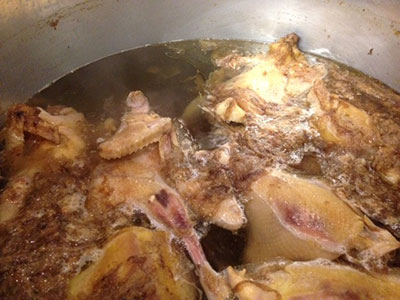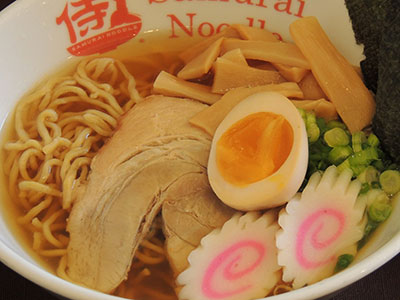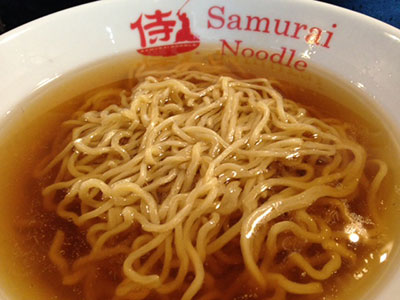Ryo's Ramen Talk No.4
Shouyu Soup (Chicken & Fish Broth)
 Here, I would like to talk about our "Shouyu Ramen” soup.
However, before I get into our main topic, I will like to first
clear up a common misconception regarding the “Shouyu
Ramen”. Shouyu Ramen directly translates to Soy Sauce
Ramen. Many people believe soy sauce is spelled or
pronounced “shoyu”, and therefore pronounce the “Shouyu Ramen” as “Shoyu Ramen”. However, the
correct pronunciation is in fact “Shouyu Ramen”. Unlike the Tonkotsu
Ramen, from the name "Shouyu ramen" alone, there is not enough
information to immediately assume what sort of broth the ramen uses.
Although "Tonkotsu ramen" is defined to be "Pork-bone ramen," the Shouyu
Ramen has been known to use various ingredients to flavor its soup.
It mainly uses chicken (or chicken bone) broth. In fact, Shouyu ramen is the
most widely served ramen in Japan (the world), so the varieties of Shouyu
Ramen found across Japan are countless. The Shouyu Ramen traditionally
uses chicken (or chicken bones), but there are types of Shouyu Ramens that mix/use fish broth,
vegetable soup, pork bone, pork back fat, shellfish, and much more. People consider Shouyu ramen to
originate from Tokyo since the arguably “first ramen shop”, Rai Rai ken, served the Shouyu Ramen from
Tokyo. But, the Shouyu Ramen represents many other regions and has been localized to be known as
the Tsugaru ramen, Kitakata ramen, Sano ramen, Kyoto ramen, Onomichi ramen, and much more!
Here, I would like to talk about our "Shouyu Ramen” soup.
However, before I get into our main topic, I will like to first
clear up a common misconception regarding the “Shouyu
Ramen”. Shouyu Ramen directly translates to Soy Sauce
Ramen. Many people believe soy sauce is spelled or
pronounced “shoyu”, and therefore pronounce the “Shouyu Ramen” as “Shoyu Ramen”. However, the
correct pronunciation is in fact “Shouyu Ramen”. Unlike the Tonkotsu
Ramen, from the name "Shouyu ramen" alone, there is not enough
information to immediately assume what sort of broth the ramen uses.
Although "Tonkotsu ramen" is defined to be "Pork-bone ramen," the Shouyu
Ramen has been known to use various ingredients to flavor its soup.
It mainly uses chicken (or chicken bone) broth. In fact, Shouyu ramen is the
most widely served ramen in Japan (the world), so the varieties of Shouyu
Ramen found across Japan are countless. The Shouyu Ramen traditionally
uses chicken (or chicken bones), but there are types of Shouyu Ramens that mix/use fish broth,
vegetable soup, pork bone, pork back fat, shellfish, and much more. People consider Shouyu ramen to
originate from Tokyo since the arguably “first ramen shop”, Rai Rai ken, served the Shouyu Ramen from
Tokyo. But, the Shouyu Ramen represents many other regions and has been localized to be known as
the Tsugaru ramen, Kitakata ramen, Sano ramen, Kyoto ramen, Onomichi ramen, and much more!
 As an especially unique Shouyu ramen, Toyama Black ramen is also very
famous. Its black color of the broth is a result from the soy sauce. Because
there are thousands of unique varieties of Shouyu Ramen, it is extremely
hard to standardize the Shouyu Ramen. Our Shouyu Ramen broth is created
using a mixture of chicken and fish, and our particular type of Shouyu ramen
has roots in Tokyo. What I originally wanted to create was a Shouyu Ramen
that we can either enjoy after drinks or at the beach. This is first of all,
because it is very common in Japan to have a bowl of ramen after we drink
(or got drunk). Whenever I am drunk in Japan, my damaged stomach can’t handle dense, greasy foods.
In these cases, I always ask for simple, non-greasy hot soup. Of these soups, I have found that the
Shouyu Ramen is my absolute favorite. Just as it is popular in Japan to eat Ramen after drinking, it is
very popular to enjoy a bowl of Ramen at the beach.
As an especially unique Shouyu ramen, Toyama Black ramen is also very
famous. Its black color of the broth is a result from the soy sauce. Because
there are thousands of unique varieties of Shouyu Ramen, it is extremely
hard to standardize the Shouyu Ramen. Our Shouyu Ramen broth is created
using a mixture of chicken and fish, and our particular type of Shouyu ramen
has roots in Tokyo. What I originally wanted to create was a Shouyu Ramen
that we can either enjoy after drinks or at the beach. This is first of all,
because it is very common in Japan to have a bowl of ramen after we drink
(or got drunk). Whenever I am drunk in Japan, my damaged stomach can’t handle dense, greasy foods.
In these cases, I always ask for simple, non-greasy hot soup. Of these soups, I have found that the
Shouyu Ramen is my absolute favorite. Just as it is popular in Japan to eat Ramen after drinking, it is
very popular to enjoy a bowl of Ramen at the beach.
 In Japan, there are
many summer-season-limited restaurants on beach. Shouyu ramen is always
a main food item at these beach restaurants. After swimming in cold waters
for many hours, a nice hot bowl of ramen is perfect for warming up a chilled
body. In both cases, several shakes of white pepper are the perfect
complement of the Shouyu ramen, so I urge you all to try it! Our Shouyu
Ramen uses wavy egg noodles, and the soup is always crystal clear.
Since our Tonkotsu broth is thick and heavy, we wanted to keep our Shouyu broth light and lean.
Preparing our chicken broth cooking doesn’t require days of boiling, unlike our Tonkotsu broth.
However, maintaining the quality of our chicken broth is a lot more difficult than maintaining our pork
broth. Keeping the clearness and temperature of the chicken broth requires precise flame control.
The Shouyu Broth’s temperature must always be right below the boiling point. Any mistake can
significantly change the flavor of the broth. Just as we only use authentic ingredients for our Tonkotsu
Broth pot, we use nothing but natural chicken and dried fish flakes in our Shouyu Broth pot.
Consequently, each of our stores has large amounts of chickens and fish flakes at the end of every night.
On a side note, Samurai Noodles receives many samples of soup ingredients and noodles from outside
sales representatives. They try to advertise their product by saying “XXXX uses this,” or “it is really good
to keep consistent pork flavor/chicken flavor,” etc. Sure, artificially synthesized products probably taste
good. Using these products is probably easier than boiling broths for days, or having to maintain flame
control. Some people most likely won’t be able to tell the difference. It also will likely lower our production
cost. However, if we sell pre-made soup ingredients or noodles that other ramen shops or even
customers can also buy, what is the meaning of our existence as a ramen shop? Is making our job
cheaper and easier worth sacrificing our tradition and originality? What sort of service and excitement
could we possibly provide for our customers if you could buy our food off a shelf at a supermarket?
At Samurai Noodle stores, we fill each bowl of ramen with our authentic Japanese ramen culture so you
can enjoy a unique experience you can’t get at home.
In Japan, there are
many summer-season-limited restaurants on beach. Shouyu ramen is always
a main food item at these beach restaurants. After swimming in cold waters
for many hours, a nice hot bowl of ramen is perfect for warming up a chilled
body. In both cases, several shakes of white pepper are the perfect
complement of the Shouyu ramen, so I urge you all to try it! Our Shouyu
Ramen uses wavy egg noodles, and the soup is always crystal clear.
Since our Tonkotsu broth is thick and heavy, we wanted to keep our Shouyu broth light and lean.
Preparing our chicken broth cooking doesn’t require days of boiling, unlike our Tonkotsu broth.
However, maintaining the quality of our chicken broth is a lot more difficult than maintaining our pork
broth. Keeping the clearness and temperature of the chicken broth requires precise flame control.
The Shouyu Broth’s temperature must always be right below the boiling point. Any mistake can
significantly change the flavor of the broth. Just as we only use authentic ingredients for our Tonkotsu
Broth pot, we use nothing but natural chicken and dried fish flakes in our Shouyu Broth pot.
Consequently, each of our stores has large amounts of chickens and fish flakes at the end of every night.
On a side note, Samurai Noodles receives many samples of soup ingredients and noodles from outside
sales representatives. They try to advertise their product by saying “XXXX uses this,” or “it is really good
to keep consistent pork flavor/chicken flavor,” etc. Sure, artificially synthesized products probably taste
good. Using these products is probably easier than boiling broths for days, or having to maintain flame
control. Some people most likely won’t be able to tell the difference. It also will likely lower our production
cost. However, if we sell pre-made soup ingredients or noodles that other ramen shops or even
customers can also buy, what is the meaning of our existence as a ramen shop? Is making our job
cheaper and easier worth sacrificing our tradition and originality? What sort of service and excitement
could we possibly provide for our customers if you could buy our food off a shelf at a supermarket?
At Samurai Noodle stores, we fill each bowl of ramen with our authentic Japanese ramen culture so you
can enjoy a unique experience you can’t get at home.
